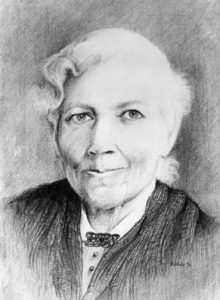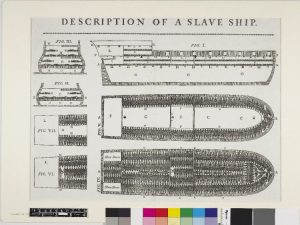Olaudah Equiano was a Nigerian-born slave who was kidnapped from his village and experienced the oppression of slavery. Equiano lived during the mid-late 18th century, which is characterized by the formation of and civil unrest within the American colonies as well as the increasing demand for African slaves. A large part of the controversy that came from Equiano’s work came from his display of appreciation towards his master’s treatment of him, despite him fully understanding the loss of freedom his slavery brought. Equiano eventually bought his freedom in 1776 for 40 pounds by running his own business while still completing his slave duties. Equiano published “The Interesting Narrative of the Life of Olaudah Equiano, or Gustavas Vassa, the African, Written by Himself” in 1789 in London where he became an avid abolitionist. Equiano personifies slavery in a way never done before to expose it for the awful institution that it is, to promote the abolitionist movement, and to force slave-owners to acknowledge the cruelty of their actions.
Category: Slave Narratives
Harriet Jacobs

During the period of Early African-American Literature, the purpose behind authors’ works of literature was to expose the brutality of slavery, to demonstrate how slavery was bad for the dominant culture, to foster a positive race, and to exhibit what blacks did and how they could contribute to the American culture. Harriet Jacobs successfully accomplished these goals in her work Incidents in the Life of a Slave Girl. In this work of literature, Jacobs recognizes her own relative privilege. In her work she shows ways she exhibits agency in how she tries to make the situation better. Continue reading Harriet Jacobs
Slave Narratives
In 1619, as early Americans settlers struggled to generate an adequate food and labor source, a Dutch ship carrying 20 African American slaves came ashore. Slaves were originally indentured servants who never got released from their work commitments. As time went on, the American economy, specifically the Southern plantation farmers, became dependent on slavery.

The trans-Atlantic slave trade ripped slaves from their homes, friends, and families, and brought them to American to be actioned off to the highest bidder. The transport of slaves through the Middle Passage entailed filthy, overcrowded conditions that resulted in the death of many slaves. In America, slaves were considered the property of their masters and received no rights or legal protections from abuse. Slaves were treated more like livestock than human beings and they constantly suffered from violence, isolation, and subjugation.
Most perpetrators of slavery believed their actions were justified by Christian rhetoric. The Curse of Ham was often interpreted as God’s assertion of African’s destiny to be slaves. Christian rhetoric was also used to suggest that slaves were saved from the savageness of Africa. Many people believed in the biological inferiority of blacks. Anti-miscegenation laws and the rise of eugenics in the nineteenth century supported oppression and constraint of blacks to maintain white superiority. The fugitive slave laws, forcing the North to be complicit in returning escaped slaves, expanded slavery into a country-wide political issue. The American reform movement developed in part to criticize slavery, which was abolished in 1865 with the passing of the thirteenth amendment.

Slave narratives were a central part of the abolitionist movement because they allowed African Americans to expose the brutalities they faced through slavery. Slave narratives put a name and a face to the victims of slavery, helping people realize the true cruelty of the institution. There were often problems of representation when white writers tried to highlight racial issues because the writers unintentionally maintained myths and discrimination of the African Americans. For this reason, blacks saw the need to write their own stories in order to show their personal experiences with oppression and exhibit what they did to overcome it. Showing their agency, the authors of slave narratives created a platform of literature that aimed to ignite moral change in America.
Three of the best-known slave narratives, written by Equiano, Jacobs, and Douglass, aimed to expose the harsh truths of slavery. In addition to highlighting abuse experienced by slaves, the narratives also wanted to show how slavery as an institution harmed the dominant culture by promoting rape and disrupting family structures. Masters treated their slaves like property in order to avoid the true wretchedness of their actions. Slave narratives tried to debunk the “kind master” myth while simultaneously showing how salve ownership could transform the kindest person into a cold, harsh monster. Another important goal of slave narratives was to oppose the “Darkest Africa” myth, which assumed African American’s darker complexion was a biological indication of their inferiority. To contrast this myth, slaves wanted to challenge racial assumptions and stress that blacks did not want to be enslaved, even if they did not actively revolt. It was important for these authors to foster a positive race consciousness in order to limit the lasting effects of racism once slavery was abolished.

By showing the problem of slavery was the institution as a whole, slave narratives pushed for the abolition of slavery to create a more ethical America. Authors highlighted the hypocrisy of Christian rhetoric in oppressing slavery and focused on the power of education and literacy in helping slaves exert agency in their own situations. Another important aspect of slave narratives was showing the struggles slaves faced in gaining freedom and living while “free” Americans. Authors wanted to resist the savior narrative, where a white person purchased a slave’s freedom. Equiano, Jacobs, and Douglas were all powerful writers who knew the importance of how the represented slavery to the public. These abolitionist writers knew they had to share their stories in order to inspire change and abolish slavery in America.
Works Consulted
Douglass, Frederick. “Narrative of the Life of Frederick Douglass.” The Norton Anthology of American Literature, edited by Nina Baym, W. W. Norton & Company, 2012, pp 1174-1235.
Equiano, Olaudah. “The Interesting Narrative of the Life of Olaudah Equino.” The Norton Anthology of American Literature, edited by Nina Baym, W. W. Norton & Company, 2012, pp 688-721.
Jacobs, Harriet. “Incidents in the Life of a Slave Girl.” The Norton Anthology of American Literature, edited by Nina Baym, W. W. Norton & Company, 2012, pp 921-942.

